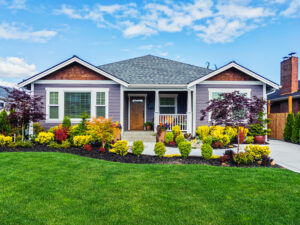Professional Landscape Design Services for Sustainable Exterior Change
Enhancing exterior areas with expert landscaping solutions can provide more than simply aesthetic charm; it can cultivate a lasting atmosphere that benefits both homeowner and the earth. From choosing indigenous plants to applying water conservation strategies and making use of environment-friendly hardscape options, the possibilities for sustainable outdoor change are huge. By recognizing the relevance of maintenance methods that support sustainability, professional landscapers can absolutely make a lasting effect on the exterior rooms they service.
Advantages of Sustainable Landscape Design
Sustainable landscaping supplies numerous ecological and economic advantages for both homeowner and the neighborhood. By applying lasting methods such as xeriscaping, utilizing native plants, and reducing water usage, homeowner can considerably minimize their environmental influence. These methods not just preserve water yet also promote biodiversity and lower the need for damaging pesticides and plant foods.

From a neighborhood point of view, sustainable landscaping plays an essential role in boosting air and water top quality, reducing city heat island effects, and offering habitats for local wild animals. These advantages add to developing much healthier and more lasting environments for everybody to enjoy.
Native Plants Option and Layout
When planning a landscape layout, selecting indigenous plants is necessary for enhancing sustainability and ecological community health. Native plants are adapted to the regional environment, dirt conditions, and pests, making them low-maintenance and more durable to thrive in their natural environment. Incorporating native plants into landscape design makes not just enhances biodiversity yet also sustains pollinators, helpful pests, and neighborhood wild animals.
Designing with native plants entails cautious consideration of aspects such as plant dimension, growth practice, bloom time, and water needs to create a aesthetically enticing and sustainable landscape. By picking a varied option of native plants, landscape designers can create well balanced ecosystems that draw in a selection of varieties and add to the overall health and wellness of the setting.
Additionally, native plants can help in reducing water intake, reduce the requirement for chemical pesticides and plant foods, and enhance dirt quality via their all-natural processes. With proper option and design, indigenous plants can change exterior spaces right into flourishing, sustainable landscapes that profit both the neighborhood and the setting.
Water Conservation Techniques
Including native plants into landscape design makes not just improves biodiversity yet also sustains pollinators, advantageous pests, and local wild animals, which underscores the relevance of implementing water conservation techniques in landscape design techniques. Water conservation is essential for lasting outdoor spaces, especially in areas susceptible to drought or water scarcity. One reliable strategy is making use of drip watering systems, which supply water straight to the plant's origin area, lessening evaporation and overflow. Mulching is an additional important practice that helps preserve soil moisture, suppresses weed growth, and enhances dirt health.

Eco-Friendly Hardscape Solutions
The utilization of ecologically aware products in hardscape layout is a crucial facet of producing lasting outdoor areas. Green hardscape remedies include a variety of techniques intended at decreasing ecological impact while enhancing the looks and capability of exterior areas. Integrating products such as absorptive pavers, reclaimed timber, recycled plastics, and all-natural stone can dramatically reduce the ecological impact of hardscape setups.
Permeable pavers, for circumstances, permit rain to seep into the ground, minimizing runoff and protecting against water contamination - Landscaping San Marcos. Recycled plastics can be changed into long lasting and low-maintenance hardscape elements, using a sustainable option to traditional products.
Upkeep Practices for Sustainability
To support the environmental honesty of eco-friendly hardscape options, executing calculated maintenance practices is vital for guaranteeing long-term sustainability in exterior landscape design tasks. Routine maintenance not only protects the aesthetic charm of the landscape but additionally adds to its general sustainability by decreasing environmental influence.
One trick maintenance method for sustainability appertains irrigation administration. Efficient sprinkling strategies, such as drip watering systems or rainwater harvesting, help save water and promote plant health and wellness. Furthermore, routine evaluation and change of watering systems can prevent water waste and make certain ideal hydration for plants.
Another essential aspect of sustainable upkeep is the liable usage of chemicals and plant foods. Opting for natural plant foods and using incorporated insect management methods minimizes hazardous chemical overflow right into the environment, safeguarding both plant life and ecological community equilibrium.
Moreover, routine cleaning and maintenance of hardscape functions like permeable pavers or rock pathways stop particles buildup and preserve performance while supporting water infiltration and drain, hence reducing the danger of disintegration and flooding. Landscaping San Marcos. By adhering to these lasting maintenance techniques, outside landscapes can flourish harmoniously while her explanation minimizing their eco-friendly impact
Final Thought
To conclude, lasting landscape design provides many advantages with making use of native plants, water conservation strategies, eco-friendly hardscape solutions, and sustainable maintenance practices. By implementing these strategies, exterior rooms can be changed into environmentally-friendly and cosmetically pleasing locations that sustain biodiversity and decrease ecological influence. Investing in specialist landscaping solutions that prioritize sustainability can lead to long-lasting benefits for both the setting and property owners.
From picking native plants to implementing water preservation strategies and utilizing environmentally friendly hardscape options, the opportunities for sustainable exterior transformation are vast. By executing lasting techniques such as xeriscaping, making use of native plants, and minimizing water use, building owners can significantly minimize their ecological effect. Water preservation is crucial for sustainable exterior areas, especially in areas vulnerable to drought or water shortage. By executing these water conservation techniques, landscaping professionals can develop stunning, sustainable outdoor spaces that profit both the area and the setting.
In conclusion, lasting landscaping supplies various advantages through the usage of native plants, water conservation strategies, environmentally friendly hardscape solutions, and lasting upkeep practices.